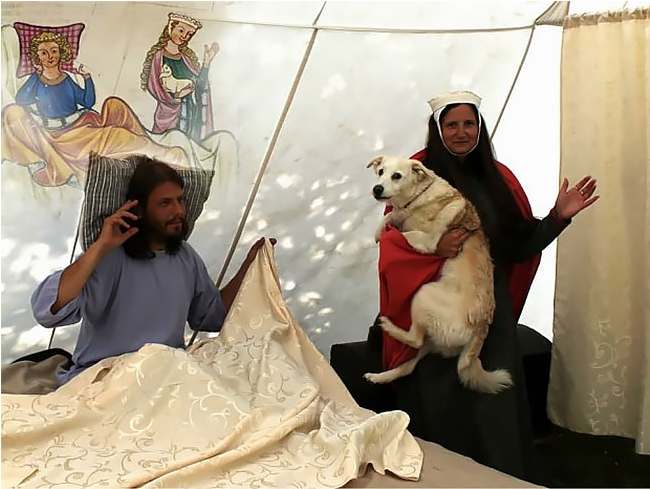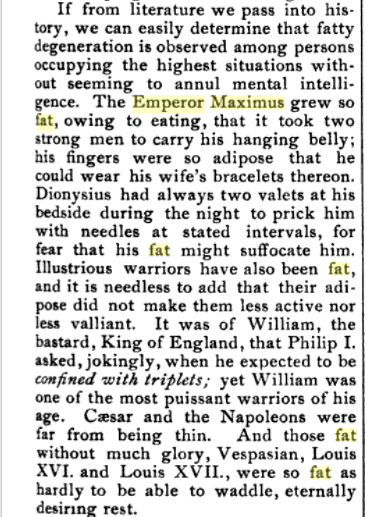History
Medieval Illustration Re-enactors
"A Group Of Czech Students Recreate Weird And Strange Scenes From Medieval Books"Many more at the source.

Posted By: Paul - Sun Dec 08, 2019 -
Comments (1)
Category: History, Hobbies and DIY, Humor, Performance Art
The Obesity of Emperor Maximus
The things you learn from perusing old comics!
Source (page 19).

Source.
Posted By: Paul - Wed Dec 04, 2019 -
Comments (2)
Category: Addictions, Eating, Body, Differently Abled, Handicapped, Challenged, and Otherwise Atypical, Obesity, History, Historical Figure
Freedom Highway
The bus as time machine.
Posted By: Paul - Sat Sep 28, 2019 -
Comments (0)
Category: History, PSA’s, 1950s, North America
Prometheus’s Garden
The creator's Wikipedia page.
Posted By: Paul - Tue Jul 16, 2019 -
Comments (0)
Category: Beauty, Ugliness and Other Aesthetic Issues, History, Surrealism, Stop-motion Animation, Bohemians, Beatniks, Hippies and Slackers, Psychedelic, 1980s
Follies of the Madmen #405

Ancient Romans drank vodka? Oh well, I suppose the ad is as authentic as the movie it references--which is actually one of my favorite comedies.
Ad source.
Posted By: Paul - Mon Jan 07, 2019 -
Comments (3)
Category: Business, Advertising, History, Unexplained Historical Enigmas, Alcohol
Home for Incurables
As late as 1952, "homes for incurables" were a going concern. Contemporary medicine seems to have abandoned the term "incurable" in favor of others that are perhaps less of a downer.
Source.

Source.


Posted By: Paul - Thu Jan 03, 2019 -
Comments (2)
Category: Architecture, Charities and Philanthropy, History, Medicine, Nineteenth Century, Twentieth Century
Bacchus After-Shave
Very strange 1969 ad campaign for Bacchus after-shave. The premise is that instead of leaving a giant horse outside of Troy, the Greeks actually left a "towering bottle of Bacchus," and that this caused the Trojan women to become so wild with lust that the Trojan men no longer had time for fighting.It then follows this up with the tagline: "The Romans conquered an empire with it. Go out and conquer yours."
But what do the Romans have to do with the Trojan horse? Rome didn't even exist at the time of the Trojan war. I guess there's a vague connection because the Romans believed they were descended from the Trojans, but even so the history seems hopelessly muddled.

Esquire - Jan 1970
Posted By: Alex - Sun Sep 16, 2018 -
Comments (4)
Category: History, Advertising, 1960s, Perfume and Cologne and Other Scents
Devolution Through Beer
Posted By: Paul - Thu Jan 19, 2017 -
Comments (5)
Category: Body Modifications, History, Advertising, Anthropology, Dinosaurs and Other Antediluvian Creatures, Fish, Alcohol
Follies of the Madmen #300

Original ad here.
Posted By: Paul - Tue Jan 10, 2017 -
Comments (2)
Category: Business, Advertising, Products, History, Tobacco and Smoking, 1950s, Men, Women
Weird Leap Year Facts
With February 29 coming up fast, About.com encouraged its writers to create some leap year-related content, so I did my part.Definitely learned some new info from writing this — such as that February is shorter than every other month because the Roman Senate, in trying to suck up to Augustus, took a day from February and added it to his month (August) to make it longer.

Posted By: Alex - Tue Feb 23, 2016 -
Comments (10)
Category: History, Holidays

| Who We Are |
|---|
| Alex Boese Alex is the creator and curator of the Museum of Hoaxes. He's also the author of various weird, non-fiction, science-themed books such as Elephants on Acid and Psychedelic Apes. Paul Di Filippo Paul has been paid to put weird ideas into fictional form for over thirty years, in his career as a noted science fiction writer. He has recently begun blogging on many curious topics with three fellow writers at The Inferior 4+1. Contact Us |




